Introduction
It touches on satisfaction other than a customer desire from consuming a particular commodity’s. The satisfaction the consumers derives from consumption of commodity is called utility. Average utility is the satisfactory per unit consumed on average. Marginal
utility is the incremental satisfaction brought about by consuming an extra unit of a commodity. All this is assessed by two schools thought
- Cardinality / Marginal utility Approach
- Ordinals Approach Indifference
3.2 Cardinalist Marginal Utility Approach
This school of taught believes that utility satisfaction is measurable by use of cardinal numbers. This theory assumes that the consumer’s satisfaction can be measured in a unit known as utils. An individual demands for a particular commodity because of the
satisfaction/utility received from consuming it. The cardinalist approach assumes that the consumer’s satisfaction or utility received from consuming a product/service. Up to a point, the more units of a commodity the individual consumes per unit time the greater
the total utility received. Total utility is the total satisfaction received from consuming a commodity. Marginal utility is the extra utility derived from the consumptions of one more unit of a commodity, the consumption of all other goods remaining unchanged. It
explains that individual demand slopes downwards from left to right because of law of diminishing marginal utilities.
The Law of Diminishing Marginal Utility (DMU)
This law states that holding other factors constant as more and more units of a product are consumed one after another the marginal utility falls as the total consumption increases..
Assumptions
1. The consumer is a rational being. As he/she consumes a commodity he goes for those commodities that give maximum satisfaction.
2. Price of commodity is constant hence marginal utility of money in constant
3. Quality of the commodity should be consumed in suitable and responsible unit hence consumption should process commodity
4. Trend of the consumer’s consumption should remain constant.
Exemption of the law of DMU
1) Desire for money, the more money one gets the more satisfaction.
2) Use of liquors-the more and more it is take the more the satisfaction derived
3) Desire for knowledge
4) Personal hobbies/ habits, more and more of this will give high satisfaction.
Application of the law
- It is applied on the bases of customers‟ behavior analysis.
- It is applied in money whereby utility of money for poor people is greater than for the rich.
- It used in the base of progressive taxation whereby the higher the income the higher the tax which led to dissatisfaction
N/B The law applies in many practical situations. For example a person on an exotic holiday to the Maasai Mara will experience increasing in total utility as his holiday proceeds but he is likely to derive greater satisfaction during the earlier days of his
holiday than during the late days.
The law of diminishing utility applies provided other factors affecting the consumer’s level utility, apart from the quantity consumed, remain constant. If any of these factors such as taste of fashion change, the law may be temporarily inapplicable until a stable
situation is re-established. For example a person may progress from an occasional buyer of paintings into an obsessive collector or art.
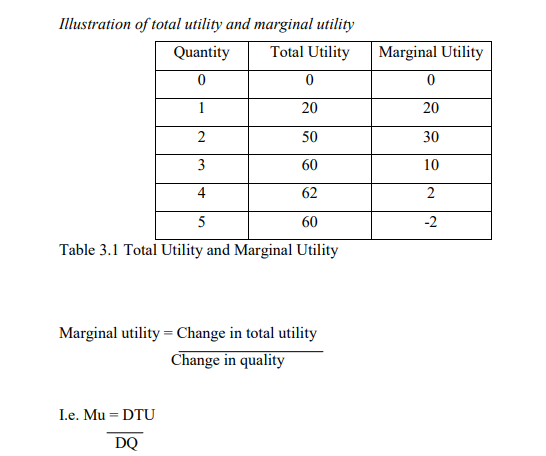
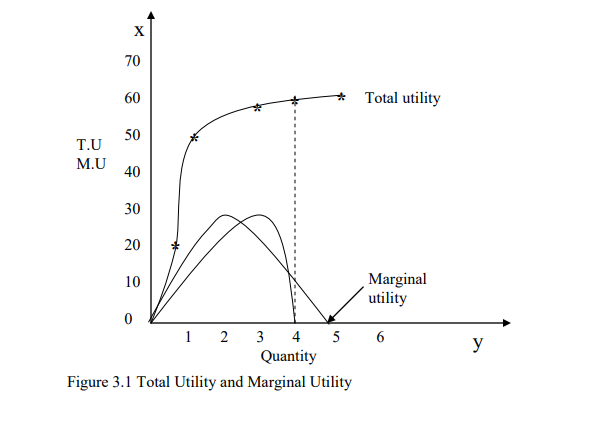
The above illustration shows the relationship between total and marginal utility.
A saturation point is reached when the utility is maximum and the marginal utility is at minimum beyond which the total utility starts to decline while marginal utility becomes negative yielding dissatisfaction.
The Limitation of Utility (Cardinal Utility)
1) It is difficult to make inter-personal comparison of utility since satisfaction is subjective
2) Measurement of utility is difficult since utility is a mental phenomenon even by the help of any instrument hence difficult to determine equilibrium position of a customer.
3) It dose not consider other factors that determine utility such as environment
4) Indivisibility of commodities is not possible to divide some goods into small units in order to equalize marginal utility
5) Ignorance of individual who are some times not aware of the substitute or different goods, e.g. cheap substitute leading items to have low satisfaction from the commodity they consume.
6) Different behaviour of individual due to different customs and fashion
3.3 Consumer Equilibrium
A consumer is in equilibrium position when he/she achieves maximum satisfaction out of the available resources. A consumer in an equilibrium position when he/she distributes expenditure on purchase of different goods in such a way that marginal utility of a
different good is equal to that of the good. This behaviour of customers is called the law of equal marginal utility. Based on the mention assumption the consumer will maximize this utility if he allocates his income in such a way that a shilling spent on one good yield as much satisfaction as a shilling spent to any other goods. The marginal utility per shilling spent on good X equals to the marginal utility spent on good Y hence consumer equilibrium is obtained when
Marginal utility x = Marginal Utility of Y
Price of X Price of Y
Mux =Muy
PX PY
The law of diminishing marginal utility is also based on the assumption that the consumer is rational. An economic agent is said to be rational when the agent exhibits behaviour which is consistent with a set of rules governing preferences. In the context of consumer
behavior this would imply the following assumption or axioms;
- The axiom of dominance which implies that consumers will always prefer more goods or less. This is also known as the axiom of non- satiation
- The axiom of selection which relates to the idea that the consumer aims for his or her most preferred state.
- The axiom of completeness states that the consumer is able to order al the available combinations of goods according to his or her preferences.
- The axiom of transivity states that if in some combination of goods; A is preferred to B and B is preferred to C then (by transivity) A is preferred to C.
Importance of Law of Equal Marginal Utility
1) It is application in consumption .A consumer can achieve maximum satisfaction when utility of different commodities is equal since the objective is to achieve maximum satisfaction.
2) Application in production. Objective of the firm is to maximize profit achieved when cost of production is minimal and when marginal productivity of all factors is equal.
3) Application is distribution. When share of different factors of production are determine, they are determined according to the principal of marginal utility
4) Application in saving and spending. A special part of the income is spent on purchase of consumer good and the remaining saved for future use.
3.4 Ordinalist / Indifference Curve Approach
This school of thought is opposed to the law that utility is measurable through cardinal numbers. This school of thought maintains that customer behaviour can be explained in terms of preference so that customers need to state the commodity they prefer without
assigning numeral values without the strength of their preferences. Consumers are expected to value their preferences of the entire service market of goods and service in order to choose i.e. combination of two goods that can be chosen if the two goods are
ranked. This is explained by the use of indifference curves. The assumptions of this approach are:
1. Price of goods is constant
2. Consumers are rational
3. Consumer can rank his/her preferences over time
4. Their behavior must be transitive i.e. if a consumer prefer A to B to l C then he can prefer A to C (axiom of transitivity)
5. Customer always prefer more to less of every commodity (axiom of non-station)
6. The slope of indifference curve gives the marginal rate of situation (M.R.S)
7. The consumer is able to order all the available combination (axiom completeness)
Indifference Curve
This is curve joining together all different combination of two goods that yield the same amount of utility to a consumer. It is a locus of point of possible combination of two alternative good that yield the same level of utility. The shape of indifference curve is
called the marginal rate of situation (MRC) i.e. the rate at which good Y can be substituted for by good X leaving the consumer at the same level of utility.
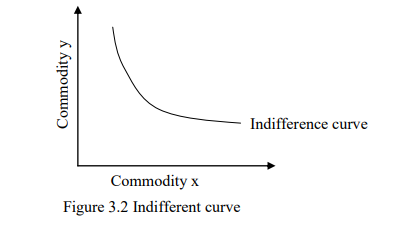
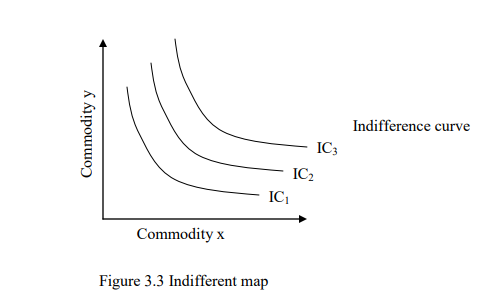
Indifference map indicate different indifference curves drawn on the same plane price with different level of utility.
Properties of Indifference
1. Indifference has a negative slope. This shows if the quality of one good say decrease the quality of other good must increase if the consumer has to remain on the same level of satisfaction
2. Indifference curve do not intersect. This is because if they did the point of intersection implies two levels of satisfaction which is not possible. consider the Figure 3.4
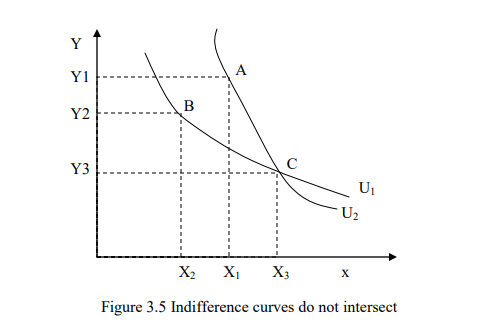
Since combination A and C are on the same indifference come u2 the consumer must be indifferent between them. Band C are on the same in difference curve u, the consumer must be indifferent between then. If the consumer is indifferent between A and C then
the he must be indifferent between A and B (considering the rule of transitivity). This is however, absurd since the combination A contains more of Y and more of X and thus preferring A to B. To be consistent with consumption assumption of rationality it can be
concluded that indifference curve cannot intersect.
3. They are convex to the original This implies that if the slope of indifference decrease in absolute terms as we move longs the curve from left downwards to the right therefore the marginal rate of the substance will be decreasing or diminishing as show in Figure 3.6.
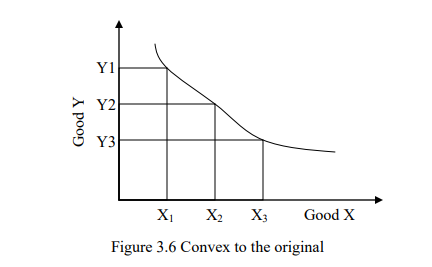
The theory of diminishing marginal rate of substitute expresses the observed behavior that as people consume more of a good, the utility they gain from each excessive unit decline. As the number of units of X the customer is will to sacrifice in order to obtain
additional unit of Y decrease as the quantity of Y rises. Therefore it is difficult to substitute X for Y as the customer consume more of y and vice verse.
3.5 Consumer Equilibrium
To explain the concept of consumer equilibrium the price of the two commodities should be given as well as the customers‟ income so as to derive the budget line. Budget line is a curve or a line showing combination of two goods that can be afforded with a given level
of income. A consumer will be at equilibrium where the budgets line is a tangent to an indifference curve as shown in Figure 3.7.
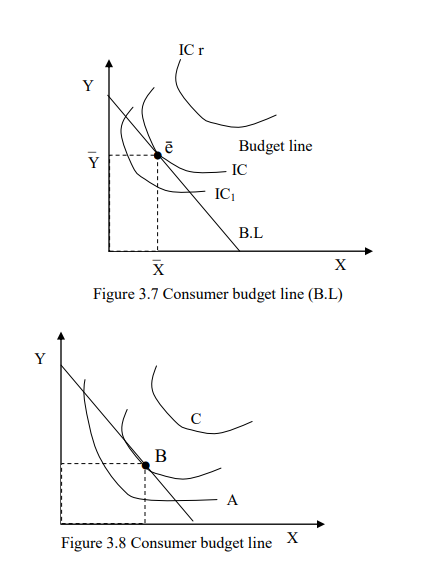
Point B is the equilibrium point where the consumer is maximizing the utility subject to his budget constraint. At point A the consumer has unutilized income and cannot derive maximum satisfaction. Point C is an attainable since the consumer’s income is limited by the marginal rate of substitution at the point B which is also the slope of budget line.
3.6 Income Consumption Curve
Increase in consumer income leads to an upward shift in the budget line such that it remains parallel to the original one and vice versa. Income consumption curve is a locus of points of consumer equilibrium resulting when only the consumer income is varied or
the consumer income change. It is also referred to as effects on an income change. The income consumption curve can be used to derive the Engel curve which illustrates the amount of a good a consumer will purchase per unit of time at various leave of income
holding the price constant.
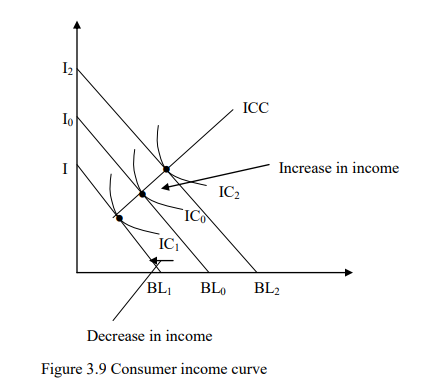
Illustration of indifferent curve for perfect substitute and perfect complimentary goods
The assumption that indifference curves are convex to the original implies that the goods are substitute but not perfect substances. In case goods are perfect substances the indifference curve is represented by a strait line with negative s lopes parallel to one another. For perfect substitutes goods the marginal rate of substitution is constant complimentary goods have indifference curves that are L shape if only they are perfect compliments as illustrated in Figures 3.10 and 3.11
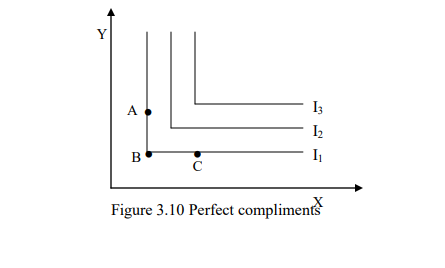
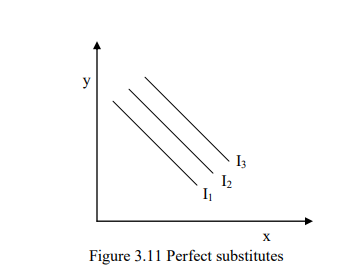
Point A, B and C are o the same indifference curve yet at point C it involves the same amount of commodity Y but more of commodity X than at point B. This implies that the customer is saturated with commodity Y and therefore the MRS=0 for both X and Y. Similar case applies at point A involving same amount of X and more of commodity of Y indicating that the consumer is saturated with commodities X and therefore the Marginal
Rate of Substitution (MRS) of X and Y =0
Application of Indifference Curves
1) It provides an explanation of the underlying reasons why change in price led to change in quality demand by distinguishing between substitution and income effects of price change.
2) It enables the derivation of normal and abnormal demand curve through price consumption curve
3) It is applied in labor economics to measure the trade off between income and leisure
4) It is used to examine the welfare affect of different Government Policy like taxes, subsidies for comparative welfare effects of direct and indirect taxes.
5) It enables assessment of the impact of change in the cost of living on welfare E.g.., the effect of change in money income and price of the welfare can be analyzed.